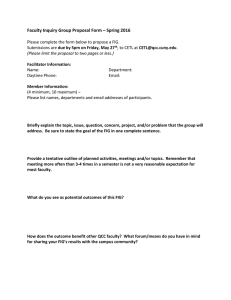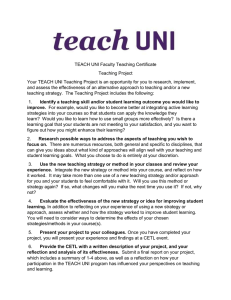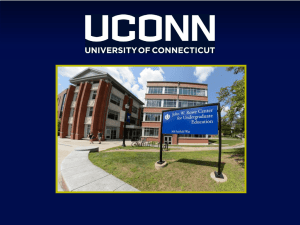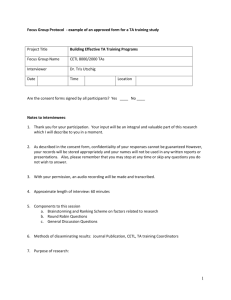CETL Conversations Words from the Director -Dr. Juarine Stewart
advertisement
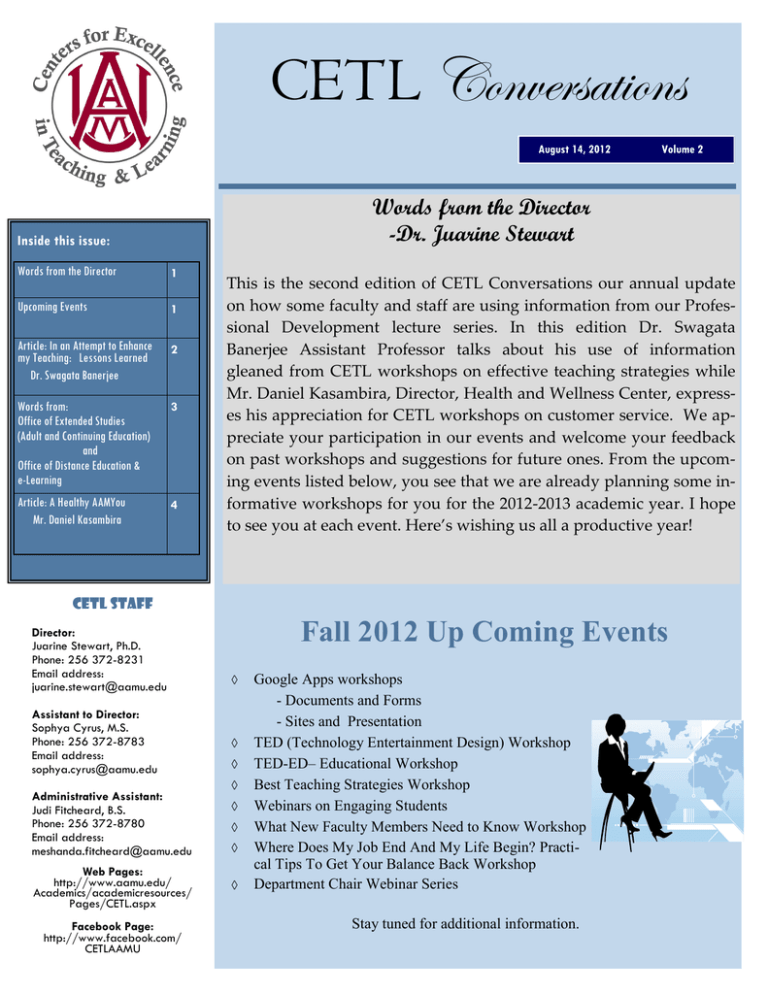
CETL Conversations August 14, 2012 Volume 2 Words from the Director -Dr. Juarine Stewart Inside this issue: Words from the Director 1 Upcoming Events 1 Article: In an Attempt to Enhance my Teaching: Lessons Learned Dr. Swagata Banerjee 2 Words from: Office of Extended Studies (Adult and Continuing Education) and Office of Distance Education & e-Learning 3 Article: A Healthy AAMYou Mr. Daniel Kasambira 4 This is the second edition of CETL Conversations our annual update on how some faculty and staff are using information from our Professional Development lecture series. In this edition Dr. Swagata Banerjee Assistant Professor talks about his use of information gleaned from CETL workshops on effective teaching strategies while Mr. Daniel Kasambira, Director, Health and Wellness Center, expresses his appreciation for CETL workshops on customer service. We appreciate your participation in our events and welcome your feedback on past workshops and suggestions for future ones. From the upcoming events listed below, you see that we are already planning some informative workshops for you for the 2012-2013 academic year. I hope to see you at each event. Here’s wishing us all a productive year! CETL STAFF Director: Juarine Stewart, Ph.D. Phone: 256 372-8231 Email address: juarine.stewart@aamu.edu Assistant to Director: Sophya Cyrus, M.S. Phone: 256 372-8783 Email address: sophya.cyrus@aamu.edu Administrative Assistant: Judi Fitcheard, B.S. Phone: 256 372-8780 Email address: meshanda.fitcheard@aamu.edu Web Pages: http://www.aamu.edu/ Academics/academicresources/ Pages/CETL.aspx Facebook Page: http://www.facebook.com/ CETLAAMU Fall 2012 Up Coming Events Google Apps workshops - Documents and Forms - Sites and Presentation TED (Technology Entertainment Design) Workshop TED-ED– Educational Workshop Best Teaching Strategies Workshop Webinars on Engaging Students What New Faculty Members Need to Know Workshop Where Does My Job End And My Life Begin? Practical Tips To Get Your Balance Back Workshop Department Chair Webinar Series Stay tuned for additional information. Page 2 Volume 2, Page 2 In an Attempt to Enhance My Teaching: Lessons Learned Swagata “Ban” Banerjee, PhD Assistant Professor of Agricultural Economics Department of Finance, Agribusiness and Economics Since I joined AAMU as faculty in August 2008, CETL has been a foothold for me insofar as professional development is concerned, particularly with respect to enhancement of classroom instruction. In the quest to improve my teaching performance, I have imbibed some of the myriad methods and techniques that CETL workshops, seminars and webinars have brought to us. Not only has this enabled me to reflect on and strengthen my inherent qualities as a teacher and my personal teaching philosophy, and develop a deeper understanding of student learning outcomes and their assessment measures, but it has also been a major contributing factor toward shaping my career path as a faculty and as a person in general. teacher, while challenging the brightest minds, I am increasingly concerned about the so-called weakest students in the class – the ones who seem to take the longest to grasp the material. Seemingly weak students challenge me to reflect upon my teaching methods and how they can be modified to overcome the weaknesses of students who often turn out to be genuine learners with untapped potential. I like to turn the weakest student’s challenge into a vehicle of innovation and improvement. Thus, my philosophy includes both concern for and curiosity about them. self. For example, I can never forget how “My Very Earnest Mother Just Served Us Nine Pickles” can conveniently be remembered for the nine planets in our solar system. In addition, I have the Herringbone Method of teaching and learning, by asking the basic universal questions such as what, who, why, when, and how. But perhaps the most interesting thing I introduced with real earnest in some of my classes is student teaching. As part of the course grade, my students now get to have their “moment” (of fame…or shame) by teaching a topic/sub-topic from their respective syllaIdeally, I like my students to find my classes bi. Since not all are comfortable with to be memorable, impactful, meaningful, “public” speaking, this measure does encounrelatable and applicable in real-life situater some amount of resistance and hesitance, tions. But I understand that not all individuals but making it mandatory leaves them no have the same cognitive learning style. Giv- choice. I believe this method inspires and In my opinion, some of the essential traits for en that they may be auditory, visual/spatial, energizes the class and teaches all students a successful teacher include patience/ or tactile (multi-sensory) learners (http:// the ideal of the proverbial “learning by fortitude, leadership, caring attitude www.learningabledkids.com/ doing.” I truly believe your teaching comes (thoughtfulness), mental strength yet flexibil- multi_sensory_training/Page10-tactile1.htm), full circle only when you have created a ity and willingness to “hit the brake” if need apart from using an array of approaches teacher. Similarly, your learning comes full to be, keeping in sight the law of averages (such as verbal lecture, using the board, circle only when you have been able to and pacing out, to keep every student on the online sources, printed handouts, images, teach. However, one thing that didn’t work same page, and willingness to be a constant references), I like to occasionally switch up for me is peer grading, because students learner/student. I want my students to know and mix between, for example, “static” and seemed to have been thinking a notch ahead that I am kind and sensitive to their emerg“kinesthetic” (mobile) cognitive teaching of me in that sphere: regardless of perforing intellect. I believe that trying to bring out styles/strategies. mance, they graded their peers with scores the best in each student and being construcstatistically not different from 100% of total tive in the ways I evaluate their work will Using CETL lessons, I have used subtle meth- scores. The only way peer grading would help build confidence and nurture their pro- ods to improve student reading comprehen- possibly work is for the ‘objective-type’ scorgress. sion. To make lessons easily readable and ing scheme. more comprehensible, I like to emphasize Students generally seem to appreciate a important words and phrases by varying Some of the activities conducted or coordistraightforward approach to learning what font style and size, highlighting, boldfacing, nated by CETL have been indirectly helping they must know in a given field. My responsi- and underlining in my notes and handouts. me contribute to the ongoing process of enbility is to convey those basic concepts well The use of mnemonics is another sleek meth- hancing the classroom environment. Over the enough to make them available and then od of ‘memorizing’ lists of important points past few years, the focus in AAMU has been insist that they are mastered. However, as a that I had successfully tried as a student my- on documenting student assessment. Coordi- Volume 2, Page 3 nating the assessment program, I have been involved in that process for our department/ unit. From understanding Benjamin Bloom’s (1956, 1992) taxonomy of using effective “upper-level” power verbs such as ‘create,’ ‘evaluate,’ and ‘analyze’ in putting together student learning outcomes (https:// www.google.com/search? q=bloom's+taxonomy&hl=en&rlz=1T4ADBR _enUS282US282&prmd=imvns&tbm=isch&t bo=u&source=univ&sa=X&ei=wx2NT8aOA 5KE8QTEtNnDQ&ved=0CDoQsAQ&biw=1280&bih=61 0) to the fact that the lesser and more focused the student learning outcomes are the easier it is to tie them to proper measures to evaluate them. From creating program- and course-level rubrics to successfully feeding data into Strategic Planning Online (SPOL), CETL has been instrumental in helping us put the pieces together. more patient and tolerant, and allowing me to think out of the box. Additionally, it makes me realize the presence of diversity of peoples, methods, styles, strategies, and measurable outcomes. After all being said and done, our ‘customers’ are our students. With no background in HBCUs prior to AAMU, I quickly ‘lived’ here what I had picked up from my graduate school days in Nevada and Georgia, which I like to call the ODIS scheme: Observe, Describe, Infer, but Suspend (Judgment). I am also constantly reminded that “Differences are a treasure, not a threat!” – Jean Vanier The Overall Impact of CETL: Helping engage students better. Enhancing overall teaching effectiveness. Increasing the quest for more/diverse ways to teach/learn. Helping become a better teacher in class. Helping become a better learner in-and-out When I think about it in a broader purview, of class. the impact this process of professional devel- Helping become a better person in life. opment has had in life in general is also undeniable. It has been making me become The Road Ahead: LET’S TALK NON-TRADITIONAL STUDENTS! -Ms. Kris E. Reed, Program Specialist Office of Extended Studies (Adult and Continuing Education) More and more students over traditional age are returning to college expecting to sharpen skills, learn new skills, or simply add a degree to help retain or obtain a job. According to the National Center for Education Statistics (NCES), in recent years, the percentage increase in the number of students age 25 and over has been larger than the percentage increase in the number of younger students, and this pattern is expected to continue. Between 2000 and 2009, the enrollment of students under age 25 increased by 27 percent while enrollment of students 25 and over rose 43 percent. From 2010 to 2019, NCES projects a 9 percent rise in enrollments of students under 25, and a 23 percent rise in enrollments of students 25 and over. Non-traditional students often lead complex lives with many responsibilities that compete with their educational goals. The greater maturity of most non-traditional students, and the complexity of their daily lives, means that they have different expectations for their learning experiences and require different ways of engagement and support from their instructors. How faculty members can engage and support non-traditional students. The first step faculty members can do is to know who these students are. Other methods to engage non-traditional students have been adopted from the adult learning community. These include: allowing for debate and challenge of ideas encouraging an exchange of ideas and opinions allowing non-traditional students to be resources to their traditional classmates. inquiring about non-traditional students’ career history and not assuming that these students cannot contribute to subject matter. offering flexibility in office hours if non-traditional students must meet before classes, after classes, or during the lunch hour. providing walk-in services (non-traditional students cannot always come back in a few hours for an appointment). For additional suggestions and tips on teaching adult students, read the article, “Tips for Teaching Adult Students” at: http://www.facultyfocus.com/articles/effective- Continue learning from seminars, workshops, webinars (not only from CETL, but beyond). E.g., going to take POGIL workshop in August 2012 in Seattle, WA). POGIL (Process Oriented Guided Inquiry Learning) is a pedagogical method devised to teach process skills (such as collaboration and written expression) as well as content using an inquiry based education approach (http://en.wikipedia.org/wiki/POGIL). Encourage more faculty members to partake in CETL and related activities. Utilize more of CETL lessons learned inand-out of class. Perhaps engage in conducting teaching/ learning workshops. Perhaps engage in writing related grants. Will welcome any suggestions/ comments/ideas/collaborations. -------------------------------------------------- THE RESOURCES OF THE OFFICE OF DISTANCE EDUCATION/eLEARNING -Tess Beebe, Instructional Design & Media Specialist Office of Distance Education & e-Learning The Office of Distance Education/e-Learning invites you to come visit in 300 Bibb Graves Hall! We have two (one Mac and one PC) fully loaded professional computer workstations where you can use high powered software and hardware to build your course or develop multimedia components for your curriculum. Whether you need ideas for mapping out your course design or someone to help you shoot and edit video, we are here to help! Let us help with your online course development by meeting early in the process to review course certification requirements, strategies and best practice for your online course delivery! We have lots of resources and plenty of ideas to share one-on-one, with teams or entire departments! Volume 2, Page 4 Daniel Kasambira Facility Director of the Health and Wellness Center This is an amazing time to be at Alabama A&M Student Health and Wellness Center and to be part of the Alabama A&M family. I am honored to serve as the director of “our” Health and Wellness Center and to work alongside such committed and talented staff. What excites me the most is that we are all part of something that is ripe with opportunity. First, it is an opportunity to galvanize ourselves around a common vision and purpose. Second; it is an opportunity to unify the experience offered to our students, faculty, staff and the community. Many of you have heard me share our mission statement of how, “we want people to feel better when you leave the facility than when you arrived.” We are committed to providing a great experience as we implement our key focus areas on a daily basis: Character-A culture of professionalism in all aspects of our operation. Customer Service-Exceed your expectations by adding value to your Student Health and Wellness Center experience. Cleanliness-It is all our responsibility to make sure the facility is kept at a high standard. Community Outreach-Partnerships with individuals, businesses, churches and non-profit organizations will assist in expanding our human and economic capital. Commitment to Staff Development-Investment in our staff will provide personal and professional growth opportunities. A healthy Alabama A&M community is critical to our success and it will take a continued commitment from everyone to succeed. Since our opening in October 2010, we have provided services to over 4,400 students and over 1,400 community members/ participants. The CETL staff has provided an array of great training opportunities which has assisted us in meeting member’s needs. We recently received the Students Choice Award for Best Customer Service for the 2nd year in a row. These types of awards are continuous reminders that training and development are essential in our quest to make Alabama A&M Student Health and Wellness Center the premiere facility in the Huntsville area. Let’s all continue the legacy of excellence that Alabama A&M University has had since its inception in 1875. Hours of Operation Facility Hours-Academic Year Monday-Friday 6am-10pm Saturday 9am-6pm Sunday 1pm-7pm Pool Hours-Academic Year Monday-Friday 7am-10am/4pm–9:30pm Saturday 9am-5:30pm Sunday 1pm-6:30pm Facility Hours-Summer Monday-Friday 6am-8pm Saturday 9am-6pm Sunday 1pm-7pm Pool Hours-Summer Monday-Friday 8am-7:30pm Saturday 9am-5:30pm Sunday 1pm-6:30pm Facility Location 4011 Meridian Street Normal, AL 35762 Phone: 256.372.7000 Fax: 256.372.7005 E-mail: healthandwellness@aamu.edu Web: www.aamu.edu/wellnesscenter Mailing Address: Alabama A&M University Student Health and Wellness Center P.O. Box 1567 Normal, AL 35762
